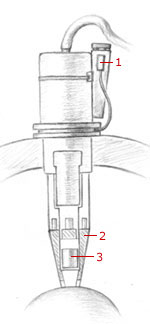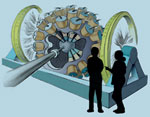Gallery: Gammasphere
Gammasphere is a $20 million detector array that helps answer fundamental questions about the structure and behavior of atomic nuclei. The device's 110 gamma-ray detectors point to the center of the spherical array, where a beam of nuclei from a particle accelerator smashes into a thin target. The collisions create unstable nuclei that decay by emitting gamma rays, an extremely high-energy form of light. Gammasphere catches and measures as many of the gamma rays as possible, so that scientists can study what happens to nuclei under extreme physical conditions. The 14-ton device, built at the Lawrence Berkeley National Laboratory by a group of scientists from several US national laboratories and universities, splits its time between LBNL in California and Argonne National Laboratory near Chicago. Since Gammasphere's dedication in December 1995, scientists from all over the world have conducted hundreds of experiments with the array.
Click here to download the pdf version of this article. |








